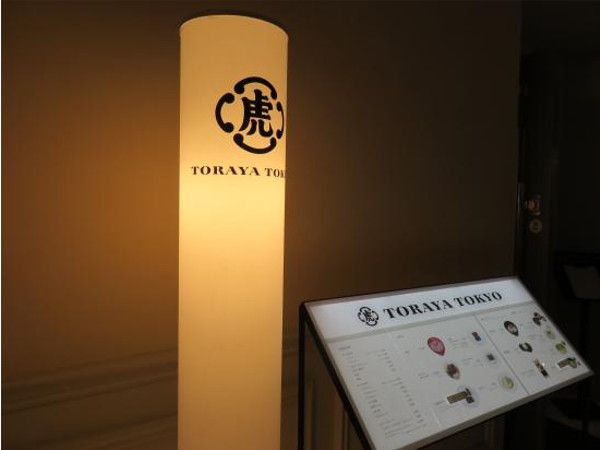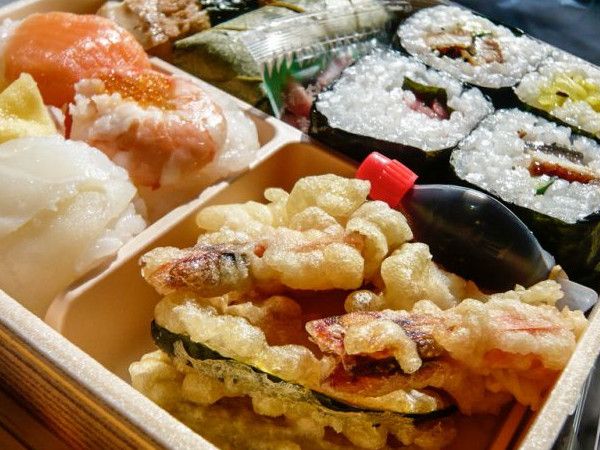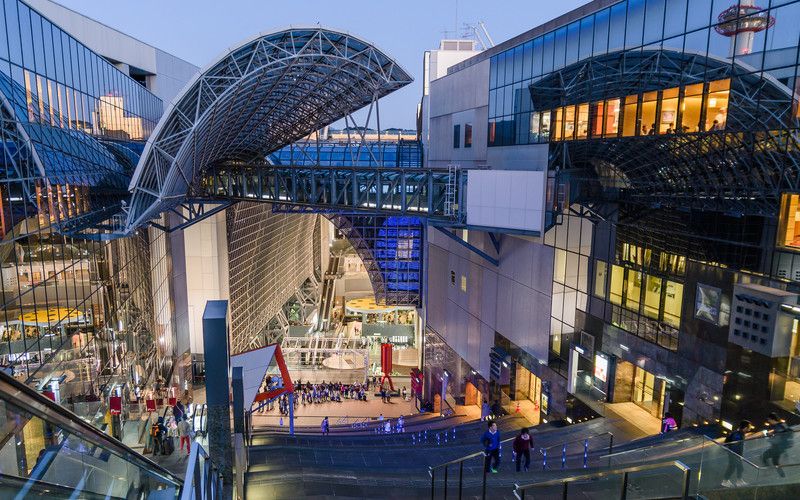Traveling can be a hungry endeavor. If you are like many travelers, sampling unique and different foods is an integral part of the journey.
Whether you are looking to grab a quick snack during a train transfer, pass the time as you await your departure, or indulge in traditional or gourmet cuisine, Japan’s train stations offer something for every taste. Extended hours and shorter wait times mean you can count on something to eat almost any time of day, whether you are starting your travels early on returning after a long day of sightseeing. Book your Japan Rail Pass today, and send your taste buds on the journey of a lifetime.
Here, we have assembled a list of some of the best restaurants and bars located inside Japan’s train stations. Their proximity makes them easy to find, convenient addition to your travel plans.
Toraya Tokyo

Toraya Tokyo offers a teashop experience like no other. Elegant lines of the tables, chairs, and benches clash with the worn brick walls, creating a visually immersive environment. Treat yourself to something sweet, or a more substantial meal, such as pickled vegetables or udon noodles.
Prices range from ¥1000 to ¥2000.
How to get there: Toraya Tokyo is located inside the Tokyo Station Hotel.
Mango Tree Tokyo
Mango Tree Tokyo offers authentic Thai food alongside a picturesque view of the city. Dishes are beautifully prepared, including edible flowers and brightly colored ingredients.
Prices: Lunches average about ¥2,900, and dinners ¥7,500.
How to get there: Mango Tree Tokyo is located near Tokyo Station’s Marunouchi exit.
Blanc Rouge
The Blanc Rouge is a fine dining experience. In 2018, it was selected for “La Liste,” a recognition of the 1,000 best restaurants in the world. It specializes in “your favorite French dishes, with modern twists.” Three private dining rooms are available.
Prices: Lunch prices range from ¥4,800 to ¥12,800, and dinner prices from ¥9,800 to ¥15,800.
How to get there: Blanc Rouge is part of the Tokyo Station Hotel, located between the Marunouchi South and Central Gates. The restaurant can be found in the hotel’s south wing.
Ekiben ya Matsuri

Japanese trains and ekiben – carefully packed bento lunchboxes featuring local fares – are inseparable. When traveling in Tokyo, you can experience different ekiben flavors from all over Japan in one place – at Ekiben ya Matsuri. In fact, Ekiben ya Matsuri carries 200 types of ekiben. Ekiben are fantastic for budget travel.
Prices: At Ekiben ya Matsuri, you can purchase items for as little as ¥140.
How to get there: This shop is located in Tokyo Station’s main passage.
Kyoto Ramen Street

Ramen is a simple noodle soup dish, but Japan has made it a fine art. Each region of Japan prides itself on its unique ramen styles. In the Kyoto Ramen Street corridor, you will find eight ramen shops, each serving its unique local varieties. Shops include Hokkaido’s Sumire, Fukushima’s Bannai Shokudo, Tokyo’s Taishoken, Toyama’s Menya Iroha, Osaka’s Araumado, Kyoto’s own Masutani, Shikoku’s Ramen Todai, and Kyushu’s Ikkousha. You can taste all of Japan without leaving Kyoto.
To order ramen, you will purchase a ticket at a vending machine and hand it to the cashier.
Prices: Servings generally cost around ¥1,000.
How to get there: The Kyoto Ramen Street is located on the tenth floor of the Kyoto Station, to the south of the Daikaidan Grand Stairway.
Kobe Gavly
If you’re on Ramen Street but looking for other dining options, look no further than Kobe Gavly. Here, you will find what’s been called “the best burger in Japan.” Kobe Gavly’s burgers are made from authentic Kobe beef, famous for its superb flavor and marbled texture.
Prices: Meals at Kobe Gavly may be more expensive than burgers purchased elsewhere due to the use of Kobe beef, ranging from ¥850 to ¥2,040.
How to get there: The restaurant is located at Kyoto Station Building 10F, near Kyoto Ramen Street.
Sushi no Musashi
Sushi plucked from a conveyor belt? That’s what you’ll find at Kyoto’s Sushi no Musashi. Chefs prepare fresh sushi to order or place it on the conveyor. With so many options at hand, you likely won’t know where to start!
Prices range from ¥146 to ¥346 per dish.
How to get there: Sushi no Musashi is located in Kyoto Station’s 1F region.
Mini-on Confectionery Shop
If you are looking to satisfy your sweet tooth, Mini-on is the place to go. You’ll find traditional sweet treats like nothing you’ve ever seen before, including pastries, pies, baked sweet potatoes, and potato chocolate sticks.
How to get there: Mini-on is located on the northeast end of the Osaka Station, near the Midosuji Ticket Gate.
Camp
If you need to get your daily serving of vegetables, Camp is the place to go. Their signature vegetable curry includes 11 different vegetables. Choose from chicken and tomato sauce, green Thai sauce, or spicy Indian sauce. You can eat at an old-fashioned lunch counter, complete with bar height stools.
Prices at Camp range from value to mid-range.
How to get there: Camp is located in the southwest section of Osaka Station, not far from the Sakurabashi Ticket Gate.
Tsurutontan Top Chefs

Tsurutontan Top Chefs is an udon noodle shop, featuring generous servings of both warm and cold udon varieties. The restaurant’s décor is brightly lit and all-white, leaving the food to provide the only contrasting colors. This causes each bowl of noodles to resemble a work of art – especially the sample dishes on display along one wall.
Prices are in the range of $12 U.S.
How to get there: Tsurutontan Top Chefs can be found on the south side of Osaka Station City, in the B2 basement level of the Daimaru department store.
Bonus: Sukiyabashi Jiro
A very small sushi restaurant in Tokyo with only ten counter seats, this establishment has been awarded three Michelin stars. The restaurant was featured in the 2011 documentary Jiro Dreams of Sushi, and one French chef stated that the restaurant taught him that sushi is an art form.
How to get there: From Tokyo Station, take the Marunouchi Line to Ginza Station. The restaurant is a one minute walk away.
Price: Unknown
So, what type of food are you in the mood for? With your JR Pass in hand, the possibilities are endless. Make train station restaurants a part of your next Japanese adventure.
